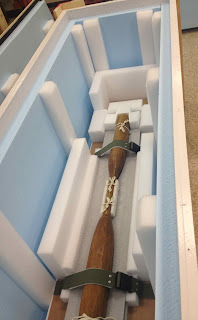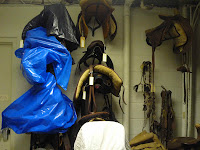by Gwen Spicer
April showers, warm temperatures causing snow melt, and streams flowing up to the edges of their banks. Each a sign of dryness. Counterintuitive? That may also be so, but it is true. Even with all this water, Spring is actually the driest time of year, and if you have a collection of artifacts to care for, this is an important piece of information.
Creating a sympathetic environment is important in both display and storage areas to assure the long-term preservation of any collection. The ideal environment includes controlled temperature and relative humidity, clean air with good circulation, controlled light sources, and freedom from biological infestation. This can be difficult in historic structures due primarily to absorption of moisture during the winter heating months that is then not lost during the summer months. However in simple terms, it has been found that by keeping a slightly wider window of acceptable humidity levels, and controlling the fluctuations, the collection and structures can remain well preserved. The conservation and museum fields are slowly learning that one needs to find a HVAC system that meshes well with the building. And of course there is a broad spectrum of needs. What about historic homes that are closed through the winter? Or museums that have separate storage, but have artifacts on display in a warm dry humanly comfortable display area? Lots of dynamics, each one different, but at their core they all must serve to preserve the artifacts within.
April showers, warm temperatures causing snow melt, and streams flowing up to the edges of their banks. Each a sign of dryness. Counterintuitive? That may also be so, but it is true. Even with all this water, Spring is actually the driest time of year, and if you have a collection of artifacts to care for, this is an important piece of information.
Creating a sympathetic environment is important in both display and storage areas to assure the long-term preservation of any collection. The ideal environment includes controlled temperature and relative humidity, clean air with good circulation, controlled light sources, and freedom from biological infestation. This can be difficult in historic structures due primarily to absorption of moisture during the winter heating months that is then not lost during the summer months. However in simple terms, it has been found that by keeping a slightly wider window of acceptable humidity levels, and controlling the fluctuations, the collection and structures can remain well preserved. The conservation and museum fields are slowly learning that one needs to find a HVAC system that meshes well with the building. And of course there is a broad spectrum of needs. What about historic homes that are closed through the winter? Or museums that have separate storage, but have artifacts on display in a warm dry humanly comfortable display area? Lots of dynamics, each one different, but at their core they all must serve to preserve the artifacts within.
A constant environment is the first means of preservation. In addition to temperature, fluctuations of relative humidity (which lead to continual dimensional changes), can damage both organic and inorganic substances. Recent research has found that it is more important to maintain constant relative humidity than it is to maintain constant temperature. A material's dimensions respond to the relative moisture content in the air rather than to the absolute temperature.
The downside to this is that the environment might not be the most comfortable for humans. It is slightly chilling in the winter and warmer in the summer, such that the relative humidity remains stable.
The graph above compares the range of indoor and outdoor temperatures throughout the year with the corresponding relative humidity (RH). Without heating, the relative humidity stays within the range limits of a safe environment. This graph represents southern New York State, but can be representative of the Northeast and many other similar areas in the country.
Below, various climates are plotted onto a hydrothermograph. The cross hatched region represents the human comfort zone in both summer and winter with the ideal environment for artifacts highlighted in the orange area. This is a visual representation to show how these areas intersect, but also diverge.
The graph above compares the range of indoor and outdoor temperatures throughout the year with the corresponding relative humidity (RH). Without heating, the relative humidity stays within the range limits of a safe environment. This graph represents southern New York State, but can be representative of the Northeast and many other similar areas in the country.
Below, various climates are plotted onto a hydrothermograph. The cross hatched region represents the human comfort zone in both summer and winter with the ideal environment for artifacts highlighted in the orange area. This is a visual representation to show how these areas intersect, but also diverge.
Why write about this now? Because this time of year just happens to be the exception. The ground might be muddy, but actually the trees and other plants are doing their utmost best to absorb all of that extra moisture and then some, all in order to leaf out. In the Northeast US, where there is a great deciduous forest, the evaporation climate goes from that of the Sahara to that of the Amazon Forest over the period of leaf emergence, which is sometimes as short a period as two weeks. Hence, it is the driest time of the year.
To see a wonderful animation of Spring making its way north along the east coast of the United States, please visit: http://sequoia.asrc.cestm.albany.edu/jrgroup/ Choose "Spring!" from the left margin, and then click on the first animation - the maximum temperature.
_____________________________
Gwen Spicer is a textile conservator in private practice. Spicer Art Conservation specializes in textile conservation, object conservation, and the conservation of works on paper. Gwen's innovative treatment and mounting of flags and textiles is unrivaled. To contact her, please visit her website.
Gwen Spicer is a textile conservator in private practice. Spicer Art Conservation specializes in textile conservation, object conservation, and the conservation of works on paper. Gwen's innovative treatment and mounting of flags and textiles is unrivaled. To contact her, please visit her website.



























